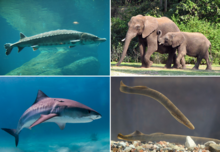 Global Information
Global InformationVertebrate information
| Vertebrate Temporal range:
Cambrian Stage 3–Present, | |
|---|---|

| |
| Diversity of vertebrates: Acipenser oxyrinchus (Actinopterygii), an African bush elephant (Tetrapoda), a tiger shark (Chondrichthyes) and a river lamprey (Agnatha). | |
| Scientific classification | |
| Domain: | Eukaryota |
| Kingdom: | Animalia |
| Superphylum: | Deuterostomia |
| Phylum: | Chordata |
| Clade: | Olfactores |
| Subphylum: | Vertebrata J-B. Lamarck, 1801[2] |
| Infraphyla | |
| |
| Synonyms | |
|
Ossea Batsch, 1788[2] | |
Vertebrates (/ˈvɜːrtəbrɪts, -ˌbreɪts/)[3] are deuterostomal animals with bony or cartilaginous axial endoskeleton — known as the vertebral column, spine or backbone — around and along the spinal cord, including all fish, amphibians, reptiles, birds and mammals. The vertebrates consist of all the taxa within the subphylum Vertebrata (/ˌvɜːrtəˈbreɪtə/)[4] (chordates with backbones) and represent the overwhelming majority of the phylum Chordata, with currently about 69,963 species described.[5]
Vertebrates comprise groups such as the following infraphyla and classes:
- Agnatha or jawless fish, which include:
- †Conodonta
- †Ostracodermi
- Cyclostomi (hagfish and lampreys)
- Gnathostomata or jawed vertebrates, which include:
- †Placodermi
- †Acanthodii
- Chondrichthyes or cartilaginous fish, (sharks, rays and ratfish)
- Osteichthyes or bony fish, which include:
- Actinopterygii or ray-finned fish, which comprises the majority of living bony fish and over half of all living vertebrates, including:
- Cladistia (bichirs and relatives)
- Chondrostei (sturgeons and paddlefish)
- Holostei (bowfins and gars)
- Teleostei (96% of living fish species)
- Sarcopterygii or lobe-finned fish, which include:
- Actinistia (coelacanths)
- Dipnomorpha (lungfish)
- Tetrapoda[a] or limbed vertebrates
- Amphibians (lissamphibians, as well as the extinct temnospondyls and lepospondyls)
- Amniotes or true land vertebrates
- Sauropsids (reptiles and birds, as well as the extinct parareptiles, dinosaurs, pterosaurs and Mesozoic marine reptiles)
- Synapsids (mammals as well as all their extinct relatives and pelycosaurid/therapsid ancestors)
- Actinopterygii or ray-finned fish, which comprises the majority of living bony fish and over half of all living vertebrates, including:
Extant vertebrates vary in body lengths ranging from the frog species Paedophryne amauensis, at as little as 7.7 mm (0.30 in), to the blue whale, at up to 33 m (108 ft). Vertebrates make up less than five percent of all described animal species; the rest are described as invertebrates, an informal polyphyletic group comprising all that lack vertebral columns, which include non-vertebrate chordates such as lancelets.
The vertebrates traditionally include the hagfish, which do not have proper vertebrae due to their loss in evolution,[7] though their closest living relatives, the lampreys, do.[8] Hagfish do, however, possess a cranium. For this reason, the vertebrate subphylum is sometimes referred to as Craniata or "craniates" when discussing morphology. Molecular analysis since 1992 has suggested that hagfish are most closely related to lampreys,[9] and so also are vertebrates in a monophyletic sense. Others consider them a sister group of vertebrates in the common taxon of Craniata.[10]
- ^ Yang, Chuan; Li, Xian-Hua; Zhu, Maoyan; Condon, Daniel J.; Chen, Junyuan (2018). "Geochronological constraint on the Cambrian Chengjiang biota, South China" (PDF). Journal of the Geological Society. 175 (4): 659–666. Bibcode:2018JGSoc.175..659Y. doi:10.1144/jgs2017-103. ISSN 0016-7649. S2CID 135091168. Archived (PDF) from the original on 9 October 2022.
- ^ a b Nielsen, C. (July 2012). "The authorship of higher chordate taxa". Zoologica Scripta. 41 (4): 435–436. doi:10.1111/j.1463-6409.2012.00536.x. S2CID 83266247.
- ^ "vertebrate". Dictionary.com Unabridged (Online). n.d.
- ^ "Vertebrata". Dictionary.com Unabridged (Online). n.d.
- ^ "Table 1a: Number of species evaluated in relation to the overall number of described species, and numbers of threatened species by major groups of organisms". IUCN Red List. 18 July 2019.
- ^ Ahlberg, Per Erik (2021). "A comparative genomic framework for the fish-tetrapod transition". Science China Life Sciences. 64: 664–666. doi:10.1007/s11427-021-1903-x.
- ^ Ota, Kinya G.; Fujimoto, Satoko; Oisi, Yasuhiro; Kuratani, Shigeru (25 January 2017). "Identification of vertebra-like elements and their possible differentiation from sclerotomes in the hagfish". Nature Communications. 2: 373. Bibcode:2011NatCo...2..373O. doi:10.1038/ncomms1355. ISSN 2041-1723. PMC 3157150. PMID 21712821.
- ^ Kuraku; et al. (December 1999). "Monophyly of Lampreys and Hagfishes Supported by Nuclear DNA–Coded Genes". Journal of Molecular Evolution. 49 (6): 729–35. Bibcode:1999JMolE..49..729K. doi:10.1007/PL00006595. PMID 10594174. S2CID 5613153.
- ^ Stock, D.; Whitt, G. S. (7 August 1992). "Evidence from 18S ribosomal RNA sequences that lampreys and hagfish form a natural group". Science. 257 (5071): 787–789. Bibcode:1992Sci...257..787S. doi:10.1126/science.1496398. PMID 1496398.
- ^ Nicholls, H. (10 September 2009). "Mouth to Mouth". Nature. 461 (7261): 164–166. doi:10.1038/461164a. PMID 19741680.
Cite error: There are <ref group=lower-alpha> tags or {{efn}} templates on this page, but the references will not show without a {{reflist|group=lower-alpha}} template or {{notelist}} template (see the help page).